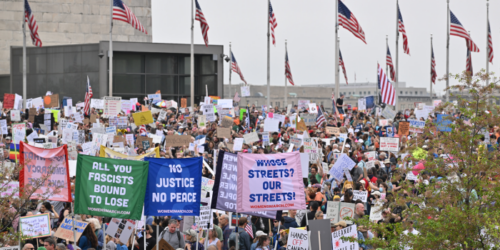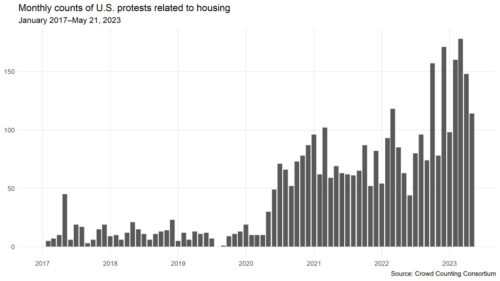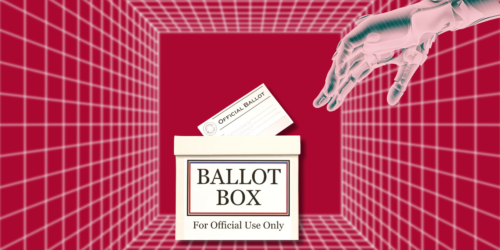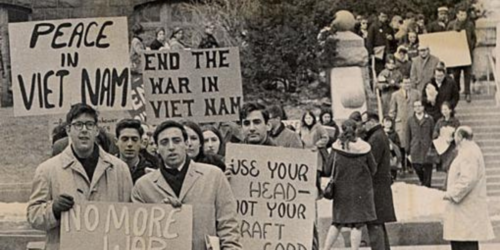On Saturday, May 20, 2023, more than 1,000 tenants, union members, community organizers, and politicians gathered at Cadman Plaza in the rain and then marched across the Brooklyn Bridge to call for lower rents in New York City and the passage of state legislation to protect tenants from eviction without good cause.
The scale and tenor of this weekend’s march reflects a broader trend in U.S. protest activity in recent years. Since early 2020, the U.S. has seen a surge in protests related to housing, Crowd Counting Consortium (CCC) data show, as rising rents, a shrinking supply of lower-cost housing, pandemic-specific stresses, and stagnant wages have driven housing insecurity to fresh extremes.
The figure below charts the dramatic increase in housing-related protests over the past few years. From January 2017 until early 2020, CCC logged an average of 11 housing-related protests nationwide each month. Since June 2020, we’ve recorded an average of 87 of these events per month. In the first four months of 2023, that average has jumped to nearly 146, and we have already logged 114 of these events in the first three weeks of May.*
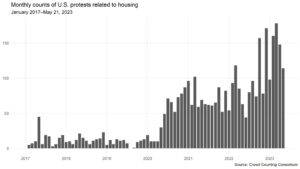
This wave of protests has coincided with an affordable-housing crisis that pairs high and still-rising costs with a shrinking supply of low-rent units. In a March 2023 blog post, the Joint Center for Housing Studies at Harvard University reported that “the number of cost-burdened renters who pay more than 30 percent of their incomes on rent hit a 20-year high of 21.6 million households in 2021,” including a record 11.6 million households devoting more than half of their incomes for housing. Meanwhile, on the supply side, “The number of units with contract rents under $600 in real terms dropped by nearly 1.2 million from 2019–2021, marking one of the largest two-year declines of the last 15 years.”
Those market trends are reflected in the demands organizers and participants have made at the protest events CCC has recorded. Early in the pandemic, we saw a spate of actions focused on the need for protections for renters whose incomes had abruptly shrunk or stopped altogether during COVID lockdowns. As the pandemic dragged on, we saw a new flurry of protests against the end of temporary eviction protections and supplemental income measures adopted by policymakers at various levels in response to those initial pressures. In recent months, rising rents have become a focal point, sparking chants like “La renta sube, sube! El pueblo sufre, sufre!” (“The rent goes up! The people suffer!), “Rent rollback!”, and, simply, “The rent is too damn high!”
The current wave of mobilization against housing insecurity also extends to areas we don’t typically think of as focal points for housing activism — including college campuses. In recent months, we’ve seen protests at schools such as Cal Poly Humboldt, UMass Amherst, and University of Rochester by undergraduate students concerned about the scarcity or poor condition of on-campus housing and the rising cost of off-campus rents. Over the past two years, we’ve also seen rallying and striking graduate students and other campus workers at schools like Cal State Long Beach and across the UC system specifically call out exorbitant housing costs as one reason they urgently need higher pay.
The ongoing housing crisis has also spurred other forms of collective action, such as rent strikes. While CCC does not track rent strikes, we have seen rallies associated with them over the past few years in cities from Oakland to DC.
Finally, all of this is happening at the same time that the number of unhoused people in the U.S. is growing; some cities and counties are adopting policies that effectively criminalize homelessness; and more unhoused people are being murdered. In the CCC data, activism on these themes runs the gamut from vigils held nationwide each winter solstice in remembrance of people who died while experiencing homelessness to extended protest encampments like Sacramento’s Camp Resolution and this year’s Stop Hunting Us action in Ashland, Oregon. In New York City just a few weeks ago, the killing on a subway train of Jordan Neely, a young and unhoused Black man, sparked a continuing series of protests that have decried intertwined problems of poverty, racism, and the dehumanization and vilification of people experiencing homelessness. None of those problems is expected to abate any time soon.
* NOTE: Some of the increase in monthly counts of housing-related protests since 2020 is due to concurrent expansions of CCC’s collection procedures, but those changes in the research process probably only explain a fraction of the growth. Since the start of 2021, the average monthly event count in the entire CCC data set has roughly doubled, from about 1,460 to 2,750, while the average monthly count of housing-related protests in the data set has more than quadrupled.
